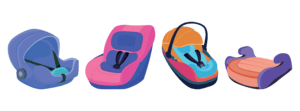
The buying journey of parents: What baby brands need to know

Marketers and consumers alike are increasingly aware that buying journeys are no longer linear. The traditional buying journey has been traditionally understood to look like this:
Awareness > Interest > Consider > Purchase
However, due to the way people buy on the internet becoming increasingly complex, the ‘interest’ and ‘consider’ phases are certainly not linear. The messy nature of the modern buyer’s journey was captured by Google, who coined the term ‘Messy Middle’.
As a mother, I often find myself in the exploration and evaluation loop of the baby industry when shopping online for the latest baby equipment. Google’s analysis is crucial for understanding purchasing behaviours across question-led industries like the baby market, so how many brands and retailers build their marketing strategies around this?
This blog builds upon Google’s findings to contextualise the ‘Messy Middle’ for the buying journey of parents. I’ve identified 4 distinctive features of the buying journey of a parent and, with each one, suggested effective marketing strategies that can align with them.
Firstly, though, let’s have a real example of when I attempted to buy a new car seat for my son…
Trying to buy a car seat

So, in the baby market, let’s take a child’s car seat. I know I need one for my child, but a search for ‘car seat’ might lead to more questions than answers. A shopping ad might attract me at first due to the image, established brand, or price. But after seeing one bad review relating to safety, a primary concern of parents, I search Google for ‘top-rated safest car seats.’ Then, I’m met with lists, blogs and Mumsnet forums weighing up the varying features and prices.
With safety being my primary concern here, I may begin to deem the cheaper offerings with suspicion and convince myself to pay a premium price. I now come across 360-degree car seats that swivel for ease of getting the child in and out of the car. Now I’m looking out for this feature, but I’m met with prices out of budget. Back to a search for a basic car seat, there are lots of options, but the ones that stand out to me are the products accompanied by video demonstrations of the installation.
But at this point, I do feel more informed, but I’m frustrated at how long it’s taking to order a car seat. And now my toddler is up from his nap, and it’s time for the baby club, where I just ask for recommendations!
I know I’m not alone with my frustrations in this market from my postpartum next-day-delivery need for a breast pump to choosing the right sleeping bag, it can be overwhelming. Now, let’s turn to the different characteristics of a parent’s buying experience…
1. Different stages of parenthood bring different feelings, worries and needs
Considering how you show up for parents in different stages of parenthood could naturally spur on some creative nuance in your marketing strategy. Expectant first-time parents often need a lot of stuff and have more questions than experienced parents. Buying decisions for a newborn pram vs. a double pram vs. a travel pram look very different, for example.
Taking first-time parents, make sure their first experiences of the baby market lead them to you through consultative and helpful content, ensuring you’re building this around questions they’re searching. Being met with innumerable choices at varying price points as a first-time parent is extra stressful, so buying guides and video demonstrations will likely be effective.
MORI, for example, has a sub-category on their site referred to as ‘hospital bag essentials’, with the category page clearly signposting their blog on the subject. Silver Cross’ blog is similarly navigable, through the content categorisation of ‘pregnancy’, ‘parenting’, ‘travel’ and ‘lifestyle’. Venicci’s blog is also full of genuine questions parents have, and it’s great to see they’ve amplified their content strategy to support the complex buying decisions parents have to make when investing in a pram.
Along with safety and cost concerns, the excitement and anticipation of a new baby are manifested in decorating the nursery! Making sure everything is perfect is a particularly strong desire of the mother at the later stage of pregnancy, which is a phenomenon known as the nesting instinct. This can manifest itself in many different ways, but one of them is making sure the nursery is perfectly designed and kitted out. Deciding on the right colours, theme and accessories for your baby’s bedroom is no easy feat with an online world of so much choice. Snuz has been helpful here and has strong organic visibility, perhaps due to helpful blog content like ‘What Colour to Paint Your Baby’s Nursery’.
Additionally, signposting that you’re on top of trends where possible, like Scandinavian decor or the rise of the beige baby, ensures the brand remains relevant across channels like social media. Pinterest, for example, is used for where people often search for very specific trends. The platform allows you to use headlines within the description of what people are actively searching for, e.g. for me, it was a ‘woodland-themed nursery’. The analytics on the platform also allow you to match how certain trends are evolving, and how they’re being described to be as relevant as possible for busy parents, all the while saving them time.
2. Safety is a priority in this market across all products, from car seats to sleeping bags.

With safety being a major concern for parents, the relevant features need to be front and centre of product pages. From my own experiences, an added safety feature mentioned or highlighted on one product can change the whole direction of my buying journey. Equally, a lack of reviews or noted safety information can deter me from a product.
While safety concerns are relevant for car seats and large furniture, safety is a priority for parents across all categories, especially any sleep-related product. The controversy surrounding sleep positioners in 2017 led to much confusion among parents and what they could use to avoid the risk of SIDS. Natural Baby Shower was timely in their response to this, and while it’s now essential for brands to create content like this, it’s still challenging to become authoritative in this space as Google will always place baby sleep charities higher in search results. Similarly, navigating the world of togs and temperatures for baby sleeping bags can prove equally as challenging!
For these concerns, video demonstrations on the product page itself can be helpful and reassuring to the user, whether that be how to set up a breast pump, swaddle a baby or install a car seat. It can also help users imagine using their product in their home or car.
The weaning stage is also one of concern in the earlier stages of the buying journey. This is full of opportunities for brands specialising in baby recipe books, food and feeding equipment to show up and answer lots of questions. When should I feed my baby? What should I feed my baby? When can my baby eat solid foods? When should my baby use cutlery? How to stop a baby from choking?
Brands wanting to show up for questions about recipes should be aware that recipe cards will typically surface at the top of SERPs, making it harder to compete for the brands whose organic listings are being pushed down. For feeding equipment, I’ve noticed baby cutlery brand Doddl segment their products by age to guide buyers. Segmenting your products like this can provide a positive user experience, and save time for the buyer while also positioning the site as a place of authority.
3. Parents are often time-constrained and need a lot of stuff
All along the newborn to toddler stage, parents are adding to all the essentials of baby equipment, and doing it under pressure and with little time! When buying a bundle of baby equipment for my son’s grandparents’ house, I actively scheduled time for this on the journey between my honeymoon and picking him up, knowing how much focus scouring this market requires. Having spare time to shop and research like this while having a toddler is very rare.
While sometimes I can make time for in-depth research and find myself scrolling Mumsnet late at night, I also have times when I’m rushing to get things ordered. During the first couple of weeks of my son’s life, as I’m sure is the case with many parents, I bought any product that told me it could aid sleep. From an urgent next-day-delivery white noise machine and baby bouncer, urgent buys in this market are likely common. After speaking to other busy parents, it’s sometimes the case that they end up paying more for products that surface first rather than using time to scroll for the best deals.
Using all the recommendations above, you can help parents think of your brand when they reach this urgent stage. You can also invest heavily in targeted Google Shopping campaigns to capture these high-intent users. Having imagery and price immediately surface for a product urgently needed is an easy win for parents trying to also save time.
4. Customer loyalty is significant in this market

Babies grow quickly and therefore need different products constantly at different stages of their development. Also, parents might spend more for higher quality products with longevity in mind for further children. So, prioritising customer loyalty can bring high rewards in this industry, especially for brands that provide products beyond the baby and toddler age.
Luxurious nursery decor brand The Gilded Bird is a great example of this. Founder and Director of the brand, Jeanie Bird, told me that:
“There’s a lot to be said about brands getting back to those simple, core ethos of offering a really good quality product, coupled with great, reliable customer service. I’ve had many parents come back to me for products for their second or third child because they know my changing mats and bedding are both beautiful and will last! They also know that if they do ever have a problem, they can get in touch and get a speedy and helpful reply. That’s a service that is disappearing in the retail world these days and yet it is worth so much to the customer.”
An easy customer journey can help build a good relationship with parents. Multi-product baby retailers have the advantage of being a one-stop shop for baby products. They can amplify this through clear signposting of bundles on their website and ads, as Online4Baby do well.
Smaller brands, especially those that have reacted to the rise in popularity of organic and natural baby products, can focus on building personal relationships with their customers.
For those with a more premium offering, making the quality and product ingredients or fabrics clear within content or ad copy can be a way of capitalising on this continuing trend.
There may also be possibilities for brands to humanise their website a lot more in this industry. For brands using parent and baby models, how about adding their names and captions to make the site more memorable? Or having an ‘As worn by…’ section on the actual product page that includes image reviews of other children using or wearing the product?
Similar strategies are sometimes used with celebrity babies, like Cozy Crew Club including a section on their site with influencer Molly-Mae’s daughter in their teddy bear romper. Or Nala’s Baby, a brand started by parents who wanted to provide an option for a toxic-free yet affordable skincare range, built their brand through this story and their lovely daughter Nala.
Customer loyalty can also be achieved through targeted Google Shopping strategies, where you can display offers for existing customers to achieve more conversions while keeping users engaged with the brand. Paid campaigns can be used to promote items to a specific user that may be part of a matching set of products they already purchased.
And, to keep the customer engaged but not overwhelm them, paid social campaigns can drip-feed the right information over time.
Conclusion
Though there will be many more characteristics to add, I’ve provided the top four buying journey elements for baby brands and retailers to consider when building their marketing strategy. The overwhelming choice of options, the question-led nature of the industry and the regular purchasing needs of parents means the brands and retailers that make it as easy as possible for parents to buy, will be the ones that succeed.
Want your brand to show up better for parents?
Implementing a strategy that is closely aligned with the distinct buying journey of parents requires strong expertise. If you’d like to chat about this industry, see which brands are dominating and what you can do about it, get in touch today.


